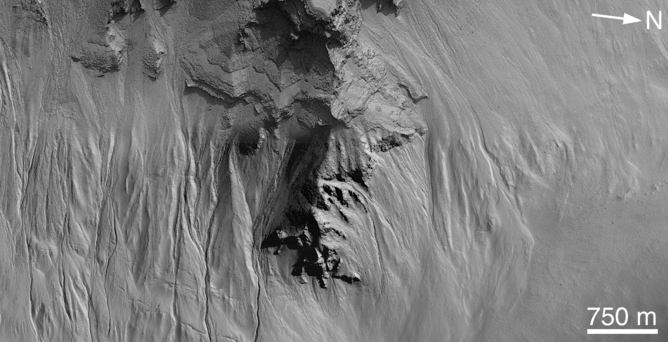David Rothery, The Open University – Water on Mars
 Scientists have found evidence of liquid water on Mars.
Scientists have found evidence of liquid water on Mars.
David Rothery, Professor of Planetary Geosciences at The Open University, explains how this exciting discovery was made.
In November 2013 I became Professor of Planetary Geosciences. I was a Senior Lecturer in the Open University Department of Earth Sciences since 1994 (transferring to the Planetary & Space Sciences Division of the new Dept of Physical Sciences in August 2011), and before that was a Lecturer here. During 1999-2004 I was Director of Teaching and Geosciences Programme Director. I have also been Leader of the IAVCEI Commission on Remote Sensing, and in 2005 I was appointed to the PPARC Solar System Advisory Panel and the BepiColombo Oversight Committee.
In May 2006 I was appointed UK Lead Scientist on MIXS (Mercury Imaging X-ray Spectrometer), which is the only UK Principal Investigator instrument on BepiColombo, the European Space Agency mission to Mercury to be launched in 2017. I became MIXS Lead Co-Investigator in 2014. I chair ESA’s Mercury Surface and Composition Working Group.
My research interests centre on the study of volcanic activity by means of remote sensing, and volcanology and geoscience in general on other planets.
Water on Mars

The discovery of water on Mars has been announced so many times that I’d forgive anyone for being sceptical about the latest announcement. Frozen water, as ice, has been demonstrated on Mars in many places, and we know of many ancient canyons carved by rivers. But we have still to find anywhere that you could throw a stone and make a splash today.
However, it now seems pretty certain that there are places where liquid water percolates downhill at the surface. This occurs mostly on sunward-facing slopes in local spring or summer, where dark streaks a few feet wide and about a hundred yards long appear, oriented downhill. These are called ‘Recurring Slope Lineae’, or RSLs, and they lengthen and then fade away seasonally. The favoured explanation since this phenomenon was first noticed a few years ago is that trickles of liquid water appear when the temperature gets warm enough, and the damp ground looks darker than the dry ground to either side. As summer progresses the water supply is exhausted, and the dark streaks fade again.
The crucial new evidence comes from the CRISM spectrometer on Mars Reconnaissance Orbiter, which has revealed hydrated salts such as magnesium and sodium perchlorate on the RSL surfaces, but not on the ground to either side. So it looks like we’ve had very salty water flowing downhill. Importantly, such salts would both slow down the evaporation of the water despite Mars’s very low atmospheric pressure, and depress the freezing point to help keep it flowing even when the temperature drops below zero.
What we’re still left pondering is whether the water oozes out from the ground or has been sucked out of the atmosphere by the salts themselves. That actually happens in Earth’s Atacama desert, and provides a habitat for microbial communities in an otherwise hostile environment. Now we wonder, if microbes can make a living like that on Earth, why not on Mars too?
Read More:





